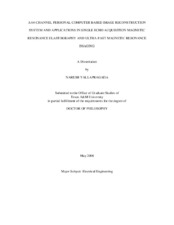| dc.contributor.advisor | Wright, Steven M. | |
| dc.creator | Yallapragada, Naresh | |
| dc.date.accessioned | 2010-01-15T00:11:02Z | |
| dc.date.accessioned | 2010-01-16T00:53:11Z | |
| dc.date.available | 2010-01-15T00:11:02Z | |
| dc.date.available | 2010-01-16T00:53:11Z | |
| dc.date.created | 2008-05 | |
| dc.date.issued | 2009-05-15 | |
| dc.identifier.uri | https://hdl.handle.net/1969.1/ETD-TAMU-2732 | |
| dc.description.abstract | Emerging technologies in parallel magnetic resonance imaging (MRI) with massive
receiver arrays have paved the way for ultra-fast imaging at increasingly high frame rates.
With the increase in the number of receiver channels used to implement parallel imaging
techniques, there is a corresponding increase in the amount of data that needs to be
processed, slowing down the process of image reconstruction. To develop a complete
reconstruction system which is easy to assemble in a single computer for a real-time
rendition of images is a relevant challenge demanding dedicated resources for high speed
digital data transfer and computation. We have enhanced a 64 channel parallel receiver
system designed for single echo acquisition (SEA) MRI into a real-time imaging system
by interfacing it with two commercially available digital signal processor (DSP) boards
which are capable of transferring large amounts of digital data via a dedicated bus from
two high performance digitizer boards. The resulting system has been used to demodulate
raw image data in real-time data and store them at rates of 200 frames per second (fps)
and subsequently display the processed data at rates of 26 fps. A further interest in realtime
reconstruction techniques is to reduce the data handling issues. Novel ways to
minimize the digitized data are presented using reduced sampling rate techniques. The
proposed techniques reduce the amount of data generated by a factor of 5 without
compromising the SNR and with no additional hardware. Finally, the usability of this tool
is demonstrated by investigating fast imaging applications. Of particular interest among
them are MR elastography applications. An exploratory study of SEA MRE was done to study the temperature dependency of shear stiffness in an agarose gel and the results
correlate well with existing literature. With the ability to make MRE images in a single
echo, the SEA MRE technique has an advantage over the conventional MRE techniques. | en |
| dc.format.medium | electronic | en |
| dc.format.mimetype | application/pdf | |
| dc.language.iso | en_US | |
| dc.subject | MRI | en |
| dc.subject | Ultra-fast | en |
| dc.title | A 64-channel personal computer based image reconstruction system and applications in single echo acquisition magnetic resonance elastography and ultra-fast magnetic resonance imaging. | en |
| dc.type | Book | en |
| dc.type | Thesis | en |
| thesis.degree.department | Electrical and Computer Engineering | en |
| thesis.degree.discipline | Electrical Engineering | en |
| thesis.degree.grantor | Texas A&M University | en |
| thesis.degree.name | Doctor of Philosophy | en |
| thesis.degree.level | Doctoral | en |
| dc.contributor.committeeMember | Ji, Jim X. | |
| dc.contributor.committeeMember | McDougall, Mary Preston | |
| dc.contributor.committeeMember | Zourntos, Takis | |
| dc.type.genre | Electronic Dissertation | en |
| dc.type.material | text | en |
| dc.format.digitalOrigin | born digital | en |


